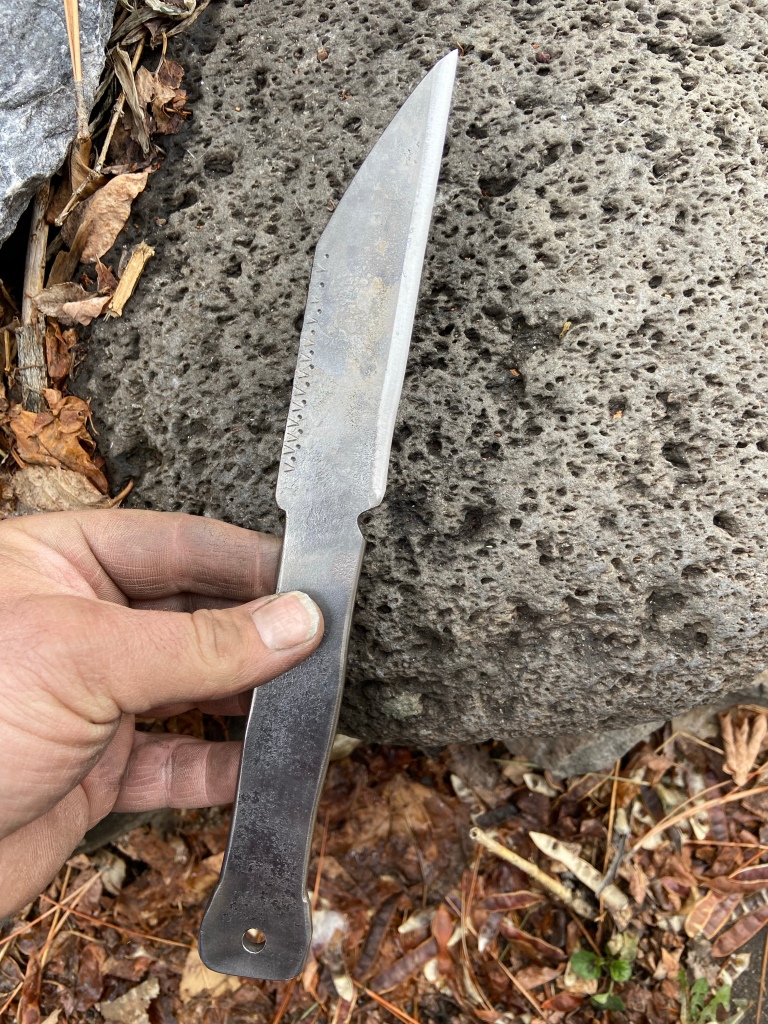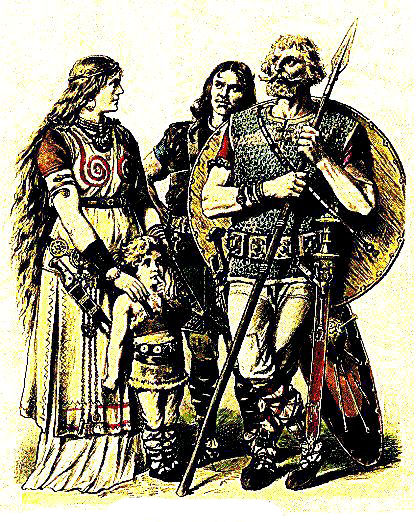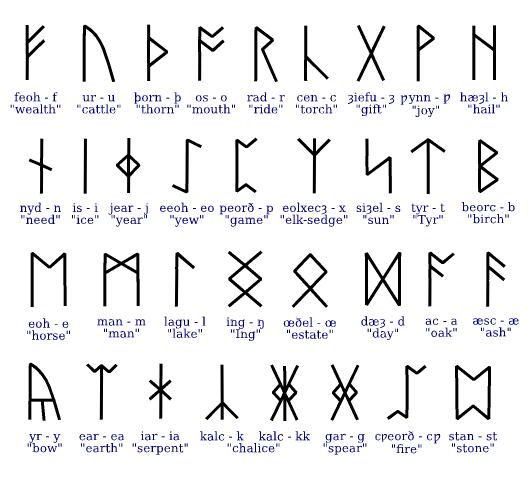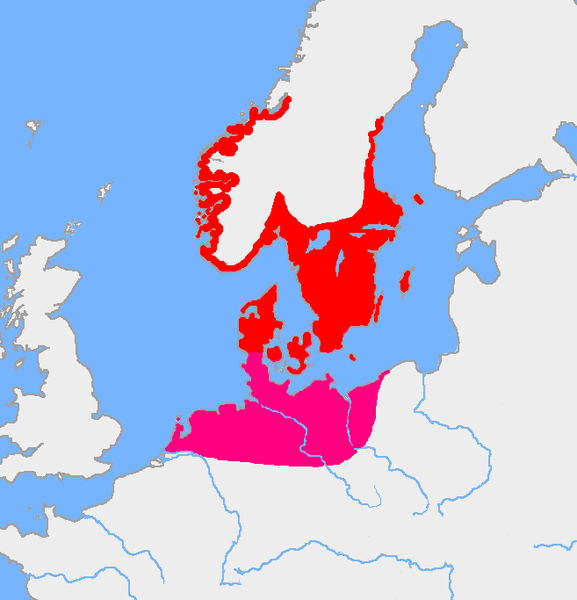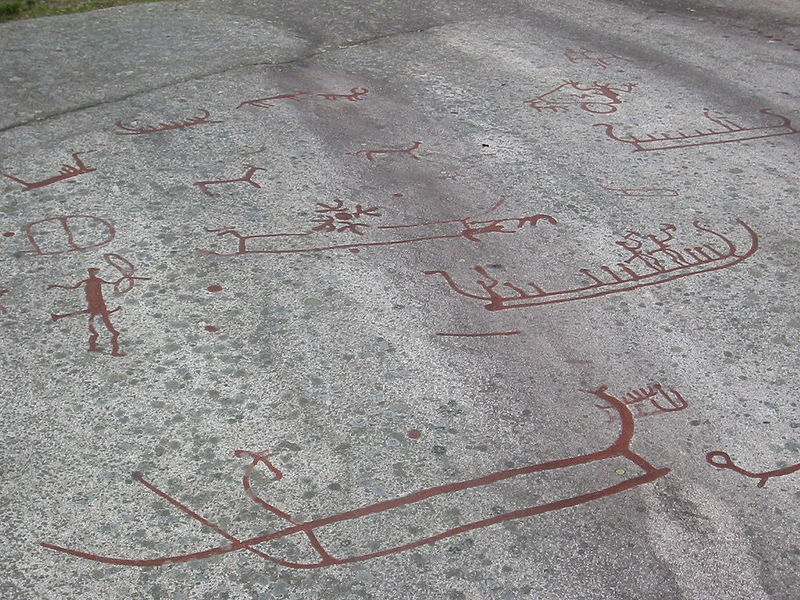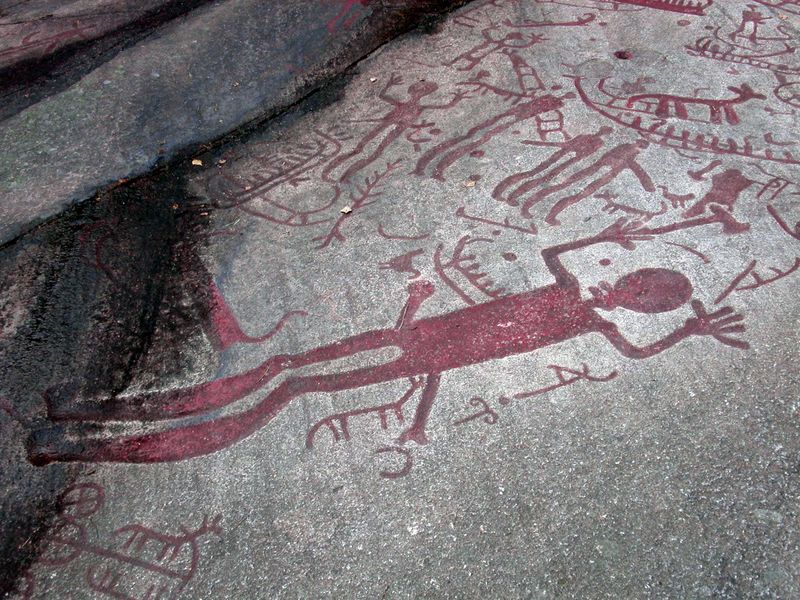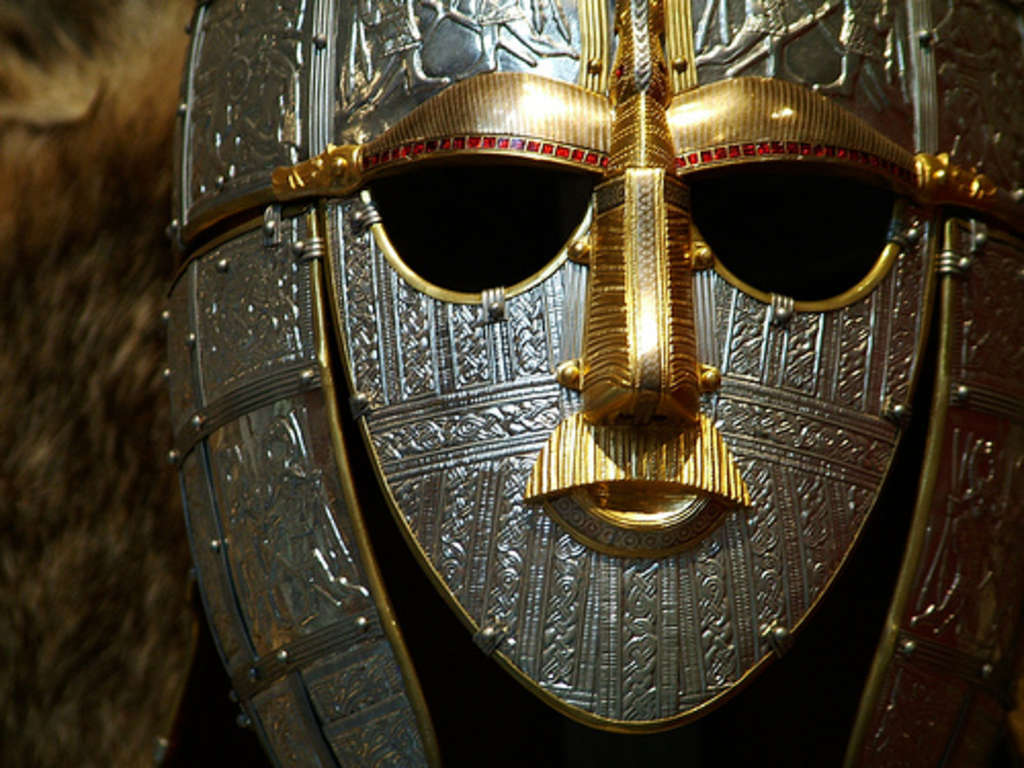Anglo Saxon word of the day: Uhta
Anglo Saxon word of þe dæg:
ūhta (pre dawn) (last part of night)
Old English: ūht (< *unhtwaz), ūhta (< *unhtwô)
Middle English: *uht (found in compound uhtsang, uhtsong); Middle English: uhhtenn, uȝten, ughten, oughten (< Old English ūhtan, oblique form)
Old Saxon: ūhta
Middle Low German: uchte
German Low German: Uchte, Ucht
→ German: Uchte (“midnight mass”) (regional)
Old Dutch: *ūhto
Middle Dutch: uchte, ochte (various forms are attested, including nuchte through rebracketing, uchten/ochten from the case forms, and rarely uchtent/ochtent from the previous by analogy with avont (“evening”))
Dutch: ochtend
Old High German: uohta (irregular); *ūhta
Middle High German: uohte, ūhte (both rare)
German: Ucht, Aucht (both only in placenames and compounds)
Old Norse: ótta
Icelandic: ótta
Norwegian Bokmål: otte
Westrobothnian: ótt’
Old Swedish: ōtta, ōta
Swedish: otte, otta
Danish: otte
Gothic: 𐌿𐌷𐍄𐍅𐍉 (ūhtwō)
Bonus:
Lagustrǣt (ocean) literally “Water-road”.
Old English: strǣt, strēt
Middle English: strete, streete, stret, strate, street, stræt
English: street
Scots: street, streit, stret
→ Breton: straed
→ Cornish: stret
→ Welsh: stryd
→ Old Irish: sráit (see there for further descendants)
→ Old Norse: stræti (see there for further descendants)
Old Frisian: strēte
North Frisian:
Föhr-Amrum: struat
Mooring: stroote
Saterland Frisian: Sträite
West Frisian: strjitte
Old Saxon: strāta
Middle Low German: strâte
German Low German: Straat, Stroot
Old Dutch: strāta
Middle Dutch: strâte
Dutch: straat (see there for further descendants)
Limburgish: sjtraot, straot
Old High German: strāza
Middle High German: strāze
Alemannic German:
Swabian: Schdrôs
Bavarian: Stråßn, Strossn
Apeltonerisch: Streoss
Mòcheno: stros
Upper Bavarian: Straß
Central Franconian: Stroß
Eifel: Strooß
Hunsrik: Stros
Luxembourgish: Strooss
German: Straße
Rhine Franconian: Schdrooß
And
West Germanic: *lagu
Old English: lagu, lago
Middle English: laȝe, lawe, laie, leye
English: lay
Old Saxon: lagu
Old Norse: lǫgr
Icelandic: lögur
Faroese: løgur
Norwegian Nynorsk: log
Norwegian Bokmål: låg
Old Swedish: lagher
Swedish: lag
Old Danish: low, lou
→ Scots: lyog
Gothic: *𐌻𐌰𐌲𐌿𐍃 (*lagus) (> 𐌻𐌰𐌰𐌶 (laaz))
Hroð-
First strike 2020

Hammer strike that is.

First forging since 2018. This amulet is inspired by a variety of sources, Primarily Hallstatt style spiral brooches but also Bronze age Axe cultures across Central and North Eastern Europe. The Axe could represent any of the Axe wielding Thunder Gods from Perkuns, þunar or Perun.
Forged Iron.
Hroðberht-
Who are the Norse People Part 2 (Germanic Culture)

Rising out of Scandinavia/Jutland the Germanic tribes brought great change to a world largely dominated by Celtic and Roman civilization. They brought with them some of the finest metal work, art, poetry and one of most well attested mythological cosmologies that is still effecting our world today. Sit back, relax and lets take a second look at the Norse (Germanic) people .
The Beginning:
Stone Age Scandinavia.
Ahrensburg Culture (c. 12,900 to 11,700 BP)

>>>>>>>>>>>>>>>>>
Fosna–Hensbacka Culture (Hunter Gatherer)
>>>>>>>>>>>>>>>>>>>>>>>>>>>>>>>
Komsa culture (Hunter Gatherer)
>>>>>>>>>>>>>>>>>>>>>>>>

Swidarian Culture. (10,000 BP)
<<<<<<<<<<<<<<<<<<<<<<<<<<

Maglemosian Culture(Hunter Gatherer)
>>>>>>>>>>>>>>>>>>>>>>>

Kongemose Culture (Hunter Gatherers)
>>>>>>>>>>>>>>>>>>>>>>>>>>>>>

Ertebølle Culture (Hunter Gatherer)
>>>>>>>>>>>>>>>>>
Pitted Ware Culture Scandinavia.
>>>>>>>>>>>>>>>>>>>>>>

Funnel Beaker Culture.
>>>>>>>>>>>>>>>>>>>>>>>>>>>>>>>>>>>>>>>>>>>>>>>>>>>>>>>>>>>>>>>>>>>>>>>>
Bronze Age Germany/Scandinavia/Poland and East/Central Europe.

Corded Ware Culture.
>>>>>>>>>>>>>>>>>>>>>>>>>>

Beaker Culture.
>>>>>>>>>>>>>>>>>>>>>

Unetice Culture. Figures (4)
>>>>>>>>>>>>>>

Urnfield Culture.
>>>>>>>>>>>>>

Nordic Bronze Age.
))))))))))))))))))))))))))))))))))))(((((((((((((((((((((((((((((((((
Early Iron Age:

Wielbark Culture Poland.
Gotland (Green)
Gotland Island (Pink)
Wielbark Culture (Goths) (Red)
……………………….


House Urns Culture (7th century BC ) (Bright Green)
Przeworsk Culture. Could be associated with the Vandalic groups but also Early Slavic tribes and was likely a culture somewhere in between these two expanding peoples.

Oksywie Culture: (Brown) A culture with possible ties to the Przeworsk culture. It is associated within the Germanic sphere of of expansion but also shows elements of La Tène and Przeworsk.

Pomeranian Culture (Pea Green)
Pomeranian Culture: Showing La Tène influence and a unique pottery style. This culture is located withing the geographic area of other early possible Germanic groups.
Cultures with foggy or debatable cultural connections or possible Germano-Celtic cultures. It has also been suggested that the “Nordwestblock” may have some undetermined influences.
The above cultures are some of the pre-historic hunter gatherer groups in Scandinavia, Poland, Germany, Baltic Coast and Central Europe. These groups undoubtedly had influence on the development of Germanic culture however some of these groups also may contributed to Balt, Slav and Celtic among others as well. In conclusion this does not mean direct exclusive development as this is largely attributed to Indo-European culture moving into contact with the earlier Hunter Gatherer cultures present at that time.
>>>>>>>>>>>>>>>>>>>>>>>>
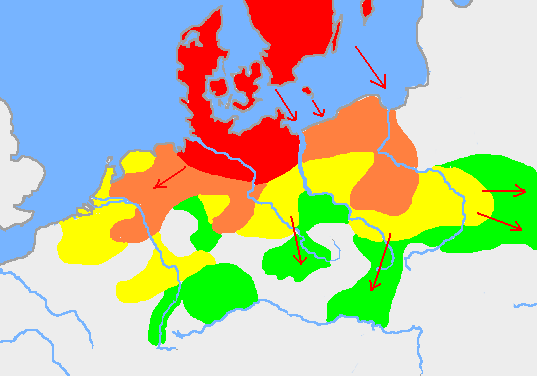
The expansion of the Germanic tribes 750 BC – AD 1 .

Nordic (Green) Jutland/Scandinavia.
Jastorf Culture (Red) Associated with the larger Urnfield cultural practices and Nordic Bronze Age traditions.

Vandalic Migration.

North Sea Germanic (Ingvaeonic) (Red)
Weser-Rhine Germanic, (Istvaeonic) (Gold)
Elbe Germanic (Irminonic) (Yellow)
East Germanic (Green)












Sutton Hoo Ship Burial. Site Contained Vendel and Anglo-Saxon Grave Goods.
Stone Ships, Circles and Dolmens associated with Germanic Cultures from around Continental Europe and Scandinavia.

Stone Ships on Gotland Island.
Funnelbeaker Graves (Germany/Scandinavia)
Tumulus:
England, Norway, Denmark, Gamla Uppsala.


Baalberge Culture Grave (Early Funnel Beaker culture) and associated Pottery.
Pottery:

Funnelbeaker era.
Corded Ware.

Sutton Hoo.

Bell Beaker Germany.
Rune Stones, Picture Stones and Glyphs (Bronze Age to Viking age)
Metallurgy:
Jewelry and Ornamentation :
Continental Iron Age.
Viking.

Visgothic.

Lombardic.

Lombardic.

Central Germanic.
Mjollnir (Thors Hammer)

Merovingian.

Simple Mjollnir.

Poland roughly 9000-10,000 years old. Mjollnir?
Cast Mjollnir and Anglo Saxon Mjollnir.
>>>>>>>>>>>>>>>>>>>>>>>>>>>>>>>>>>>>>>>>
Swords, Helmets, Armour:

Vendel Helm.
The weaponry shown above represents the mass variety of pieces from stone age to iron age across Scandinavia, Germanic Europe, Poland, Baltic lands and Alps.
The People:
The Gods:

Odin-Wotan-Woden-Gautr-Fimbultyr-Sigföðr-Allfather-Siggautr
All Father, Sky Father, God of victory, poetry, ecstasy and God of Witches and Sorcerers. Wisest among all Gods (Though Frikka knows more). He is ruler of Asgard and the one who reached into Ginnungagap as he hung from Yggdrasil and claimed the Runes.
https://en.wikipedia.org/wiki/List_of_names_of_Odin
A list of Odin’s various names.

Freyja-Frigg-Frigga-Frikka
(My opinion) is Frigga/Freyja are the same Goddess and the difference is only linguistic as well as the Goddess Jord is related to Frigga. Again this is a personal opinion derived from my own research.

Frau Holle-Frau Hulda
Perchta/Berchta is another form of this Goddess and it could be argued that these are again aspects of Frigga and that Frigga herself is just far to simplified in folklore. This is my personal opinion via research regarding Eastern German Folklore depicting the Wild Host and other Christian Yule tradition in North Eastern Germany.


Thor-Donar-Thunar-Tor
Son of Odin and Jord, great protector of Midgard and slayer of the ancient forces of chaos. Thor is among the most misunderstood Gods in the pantheon and his identity as a Shamanic figure of evolution and intelligence is rarely picked up on. Thor has many more layers to him and the knowledge I have of him as a Deity is personal and I will not divulge it here but I highly recommend taking a longer look and more open minded view of this Thunder God highly associated with positive change.

Yngvi-Freyr

My Totemic take on Ynvi Freyr.
Ing-Yngvi-Freyr is the God of fertility and is often associated with dear antlers and once had a magic sword he had lost in a bargain for the heart of a Frost Giant. He uses an antler to fight Surtr during Ragnarok.

Skadi.
Jotun Goddess associated with the wilderness, skiing and hunting. Had an ill-fated marriage with with Njord the Sea God. She is known for her steel focus and ferocious connection to the wild.


Njord.
God of the Sea, Fishing, Wealth and Fruitful Crops. He is the Father of Freyja and Freyr and is a Vanir. The Vanir are the oldest tribe of Gods.

Loki.
Due to a lack of remotely flatting art regarding Loki I have including a carved stone thought represent Loki. Loki is a maligned figure and his roll is largely misunderstood to this day. Despite his negative reputation he is a God of change, inevitable nature of things and is often referenced as a Fire God. This could be due to the destructive yet cleansing nature. Loki is the blood brother to Odin.

Heimdallr.
The shining God and owner of Gjallarhorn. Son of the 9 mothers and the Guardian of Bifrost.

Jörð.
Earth Goddess and Mother of Thor with Odin. (May be associated again with Frigga)

Nerthus-Nerþuz
Suebian fertility Goddess venerated in sacred groves. Etymologically could be linked with Jörð.


Surtr.
Jotnar/God of fiery Chaos, destruction and guardian of Muspell. Battles Yngvi at Ragnarok.

Giantess Gunnlöð daughter of Suttungr and guardian of the mead of poetry.

Ægir.
Jotnar Sea God known for his mead brewing and feasting with the Gods of Asgard.

Iðunn.
Goddess of youth/fertility and prominent figure in Lokasenna. Her apple keep the Gods young in the myth.
Tyr.
God of sacrifice and first Germanic Deity to hold the name Sky Father. He is associated with the very early Germanic Deity Tuisto and Proto-Indo-European Dyeus. He is the God who allows Fenrir to bite his hand off while permanently chaining him.
Hel.
Goddess of the underworld and daughter of Loki.
Fenrir.
Son of Loki and wolf who takes Tyr’s hand. Fenrir battle Odin at Ragnarok.

Jörmungandr.
Son of Loki. Serpent that encircles Midgard.

Vili and Vé (Odin center) are Odin’s Brothers and Sons of Bestla and Borr.

Baldr.
Son of Odin and Frigga. Subject of one the most well known narratives in Norse Cosmology involving Loki, Hel and Hermod entering the Underworld.
Hermóðr.
Son of Odin and messenger of the Gods. Rides to Hel on Sleipnir to bargain for Baldr’s return in Gyfaginning.

Sif.
Sif is the wife of Thor and Goddess of the harvest (Wheat). She is famously the center of a cycle between Loki and Thor where Loki cuts her hair but then in apology has golden hair made for her via the Dwarves.
Sunna: Norse Goddess of the Sun.

Mani: Norse Moon God. Image depicts Mani and Sunna being pursued by wolves.
Beings from Norse cosmology in small sample.
Valkyries:

Beings of supernatural origin:
Der Erlkonig.
A dark or evil character literally “King of the Elves” is a poem by Johann Wolfgang von Goethe regarding an earlier tale inspired a Danish folk story. In the Danish story it is the “Erlkings” daughter.
German:
Wer reitet so spät durch Nacht und Wind?
Es ist der Vater mit seinem Kind;
Er hat den Knaben wohl in dem Arm,
Er faßt ihn sicher, er hält ihn warm.
“Mein Sohn, was birgst du so bang dein Gesicht?” –
“Siehst, Vater, du den Erlkönig nicht?
Den Erlenkönig mit Kron’ und Schweif?” –
“Mein Sohn, es ist ein Nebelstreif.”
“Du liebes Kind, komm, geh mit mir!
Gar schöne Spiele spiel’ ich mit dir;
Manch’ bunte Blumen sind an dem Strand,
Meine Mutter hat manch gülden Gewand.” –
“Mein Vater, mein Vater, und hörest du nicht,
Was Erlenkönig mir leise verspricht?” –
“Sei ruhig, bleibe ruhig, mein Kind;
In dürren Blättern säuselt der Wind.” –
“Willst, feiner Knabe, du mit mir gehn?
Meine Töchter sollen dich warten schön;
Meine Töchter führen den nächtlichen Reihn,
Und wiegen und tanzen und singen dich ein.” –
“Mein Vater, mein Vater, und siehst du nicht dort
Erlkönigs Töchter am düstern Ort?” –
“Mein Sohn, mein Sohn, ich seh’ es genau:
Es scheinen die alten Weiden so grau. –”
“Ich liebe dich, mich reizt deine schöne Gestalt;
Und bist du nicht willig, so brauch’ ich Gewalt.” –
“Mein Vater, mein Vater, jetzt faßt er mich an!
Erlkönig hat mir ein Leids getan!” –
Dem Vater grauset’s; er reitet geschwind,
Er hält in Armen das ächzende Kind,
Erreicht den Hof mit Mühe und Not;
In seinen Armen das Kind war tot.
English (Literal):
Who rides, so late, through night and wind?
It is the father with his child.
He has the boy well in his arm
He holds him safely, he keeps him warm.
“My son, why do you hide your face in fear?”
“Father, do you not see the Elf-king?
The Elf-king with crown and cape?”
“My son, it’s a streak of fog.”
“You dear child, come, go with me!
(Very) beautiful games I play with you;
Many colorful flowers are on the beach,
My mother has many a golden robe.”
“My father, my father, and do you not hear
What the Elf-king quietly promises me?”
“Be calm, stay calm, my child;
Through dry leaves the wind is sighing.”
“Do you, fine boy, want to go with me?
My daughters shall wait on you finely;
My daughters lead the nightly dance,
And rock and dance and sing to bring you in.”
“My father, my father, and don’t you see there
The Elf-king’s daughters in the gloomy place?”
“My son, my son, I see it clearly:
There shimmer the old willows so grey.”
“I love you, your beautiful form excites me;
And if you’re not willing, then I will use force.”
“My father, my father, he’s touching me now!
The Elf-king has done me harm!”
It horrifies the father; he swiftly rides on,
He holds the moaning child in his arms,
Reaches the farm with great difficulty;
In his arms, the child was dead.
>>>>>>>>>>>>>>>>>>>>>>>>>>>>>>>>>>>>>>>>>>>>>>>>>>>>>>>>>>>>>

Meadow Elves.

Elves and Tomte from a children’s book.

Tomte or Jul Nisse.
A friendly house spirit in Scandinavian lore associated with the Jul.
Trolls.

Fossegrim.
A mythical mill or water spirit associated with waterfalls. He is known to be a master fiddle player (Hardanger). He can be given offers to teach his craft.
Nokke.
The dangerous water spirit known for taking the lives of people near water. Some times seen as a horse.

Rübezahl.
Woodwose or Mountain Giant from Eastern Germany/Poland/Czech. He is proposed to be in the Mountains between Bohemia and Silesia.

Norwegian Sea Serpent or Water Troll.
https://en.wikipedia.org/wiki/Old_Norse_religion
https://en.wikipedia.org/wiki/Norse_mythology
https://en.wikipedia.org/wiki/Dwarf_(mythology)
(Further reading) check for citations as Wikipedia is being vandalized regularly by revisionists.
>>>>>>>>>>>>>>>>>>>>>>>>>>>>>>>>>>>>>>>>>>>>>>>>>>>>>>>>>>>>>>>>>>>>>>>
Heroes: (Myth and Historical)
Redbad the Frisian.
Famous for refusing conversion to Christianity.
Widukind: A Saxon rebel against the Christian Franks.
Sigurd (Siegfried) Famous dragon slayer and central role in Nibelungelied.
“Herman the German” Arminius who rallied a confederation of Germanic tribes against Rome. The resulting Battle of the Teutoburg Forest is one of the worst defeats in Roman history.
Beowulf (Geatish warrior) Central figure in one of the greatest works of Germanic literature. (Beowulf)
A sample of a few well known heroes in history, myth or both.
Sigríð Storråda.
Regardless of whether every account is true this legendary female Hero is nothing short of inspiring for her conviction to the Gods and her honor.
Raud The Strong.
Legendary Viking who defied Olaf and died refusing conversion.
Wiglaf: Faithful Thane to Beowulf and last of the Wægmunding clan. Instrumental in aiding Beowulf in the defeat of the dragon.
Dietrich Von Bern: Image of Dietrich Von Bern and Hildabrand. Dietrich Von Bern is a German hero/legendary figure possibly based on Theodoric The Great.
Theodoric The Great: Ostrogoth King of Italy. Most likely the subject in the the various epic narratives regarding Dietrich Von Bern.
A small sampling of Historical and mythical heroes in Germanic culture.
Interesting extras:
Golden Horn of Gallehus:
An deeply interesting find with enigmatic figures, Proto Norse inscriptions and possible ciphers . Horn shows a 3 headed figure, a Cernunnos like being and what appears to show mythical creature, ritual and dances.

Nordic Bronze Age Shaving Razor.

Sutton Hoo Helmet.
Long Ships,

Maypole.

Irminsul.
Yggdrasil and The Norns.
A sample List of individual tribes:

Goths (Geats-Visigoths-Ostrogoths-Gepids-Greuthungi-Thervingi)
Teutons.
Bastarnae
Ambrones
Cymbri
Saxons
Angles
Jutes
Frisians
Franks
Vandals (Vendel-Lugii)
Langobard/Lombard
Alamanii
Suebi-Suevi
Swedes
Danes
Norwegians (Rugians)
Cherusci
Chatti
Ingaevones (North Sea confederation)
Istvaeones (Rhine area tribal group)
Irminones (Elb Germanic group)
Hermanduri
Bergundians
Heruli
Lemovii
Buri
Diduni
Harii
Helisii
Helveconae
Manimi
Nahanarvali
Scirii
Hasdingi
Silingi
Vidivarii
The list above is an example not a complete list.
Proposed Norse Cosmology:

Norse Cosmology Henry Wheaton 1831.

>>>>>>>>>>>>>>>>>>>>>>>>>>
Female Warriors:

Birka Shield Maiden: Historical person.

Brunhild: (Mythical) Central character in Völsunga saga. She depicted as a powerful Nordic queen and warrior.
Hervor: (Myth and Possibly Historical) She is featured in the Tyrfing Cycle where she is a powerful warrior renowned for her strength and possession of Tyfing. She acquired the sword from a haunted island where she summons her dead father and demands the sword. During this event her crew flees in fear. As the daughter of Heidrek she is a Gothic warrior who dies in battle against the Huns.
Freydís Eiríksdóttir: (Historical) Daughter of Erik the Red and like her father renowned for fierceness and a violent temper. she is implicated in several events to have taken place in Vinland (North America)
![6028d3e4a69ed2c1fe0c65ddab1c332c[1]](https://norsespirit.files.wordpress.com/2019/12/6028d3e4a69ed2c1fe0c65ddab1c332c1.jpg)
Veborg: Legendary Scandinavian Shield Maiden.
>>>>>>>>>>>>>>>>>>>>>>>>>>>>>>>>>>>>>>>>>>>>>>>>
Days of the Week:
Sun-Day (Sunna)
Moon-Day (Mani)
Tyr’s-Day (Tyr)
Woden’s-Day (Odin)
Thor’s-Day (Thor)
Friggs-Day (Frigga)
Saturn-Day (Disputed and may have a different etymology)
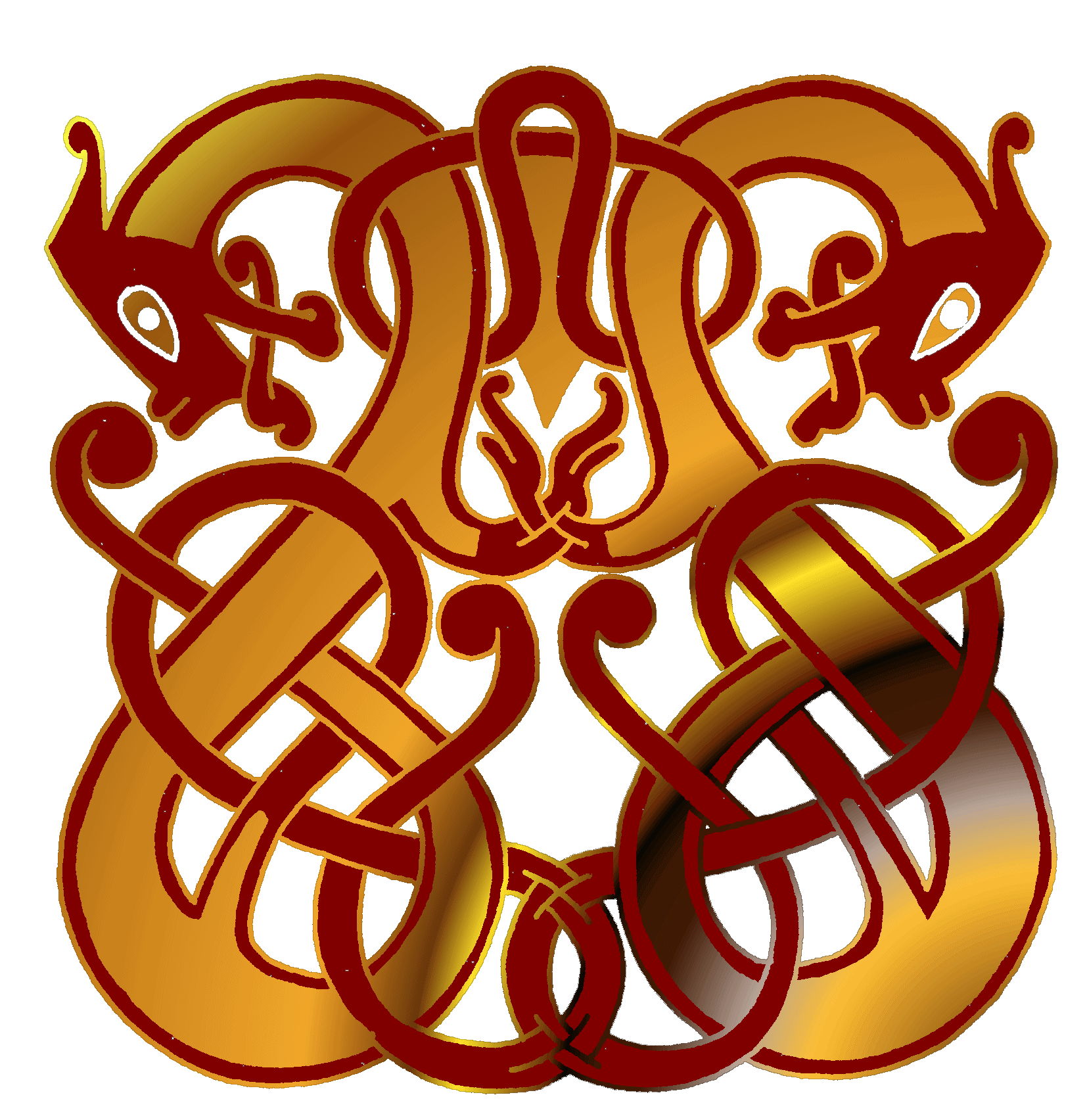
In Conclusion I hope I have created a visual narrative across the deep history of Germanic culture. Again all images are collected from the Internet and are used for educational purposes only.
Until the next time take care and thank you for taking a look at my blog. My apologies for any typos or missed/mixed up chronology.
Cheers!
Hroth-
New Creations April 2013 (Gallery) Jewelry and Knives.
Detailed obscure Celtic amulet etched into 24 gauge brass.
Scandi edge riveted 1080 modern Viking knife.
Germanic -Anglo Saxon eagle etched in brass.
New smaller iron Mjollnir design.
Not metal but an antler Mjollnir!
Bronze Athame or Witches dagger.
1080 Scandi edge (utility) with stag handled.
Arm and Neck rings in Nordic bronze style.
A good variety of projects!
Hrodberht-
Iron: Maximum Hardness For Weaponry (1018) (Low Carb Steel) BULLET POINTS.
What We know:(1018)(Low Carbon)
If you heat iron and quench in water it will get a bit harder.
Quench in oil it will get harder.
Hammer while cold it will get even harder like copper/brass/bronze.
Forge in coal for long enough in the right circumstance you can carburize/surface harden.
Coal forging can help maintain carbon content.
What actually happens: Quenching.
Carbon molecules get trapped inside iron molecule formations causing a hardening effect. Less carbon=less effective.
What actually happens: Cold hammer hardening.
The crystal structure in the steel is forced to deform causing hardening effects.
BEST WAY TO GET MAXIMUM RIGIDITY AND HARDNESS:
All the above methods are true and work to some extent, but if you find your self in the Zombie apocalypse as has been a hilarious and enjoyable topic as of late then you may need some on the fly Macgyver skills in weapon creation.
Take you bar stock or junk steel: flat,square or round (Round/Square may yield better results than flat)
Hammer the steel flat or lengthen the flat by hammering on edge then on flat side (Were deforming crystals)
Continue to work the steel while hot and create as much of the blades form while hot (Edges, point, handle)
Once done with you shape use your Ball-Peen (Round side) to pit the flat body of the blade while hot. Do both sides thoroughly.
OK NOW STOP!!!!!!!!Do not quench!!:
You have through the above process changed the crystal structure of the iron by deforming it while hot. Allow to cool naturally until it is able to be handled.
It should be extremely hard if not impossible to bend at this point by hand. Keep thickness at around the thickness of “2 quarters”.
Place cold steel on anvil and begin using the round end of your Ball-Peen on the cutting edge and main body.
As you hammer, the steel will continue to harden.
Straighten blade by hammering.
The blade will now be at maximum hardness and rigidity. If your edge is uneven simply grind/stone to desired level.
The result is now much harder, and more durable than quenching because the interior structure is effected more than when quenching in liquide.
This is now a primitive but formidable weapon with high durability. I had read some similar info a long time ago but I have always used this kind of material for ornamental purpose, after a week of forging a Athame and the quench actually softened the thin steel, I realized I had actually undone the hardening that occurred while hammering. This in my opinion is the best way to finish anything ornamental or otherwise when using a low carbon steel. The end result also looks beautiful! A good technique to remember when crafting an on the spot tool as well. Again nothing will ever make this as good as HC steel but this material continues to be the most fun to test and experiment with. Again not my own original concept I but it has been enjoyable testing it and coming upon it again in a way by accident. Good knowledge to have.
Final Note:
Know what you have and how it works!
Blade (hot hardened) and then cold hammer hardened (No Quench). Will not bend or budge.
H-
Who are the Norse people (History/Culture post)
The Norse/Germanic people : A brief history:
The history of the Nordic people begins in Central Asia and the Russian steppe when the Indo-Europeans start migrating west into modern-day Europe. During the great migration a branch of the IE moved into present day Scandinavia and became isolated most likely due to climate disruptions. Human beings have occupied Scandinavia for at least 11000 years. It is in the forest and frozen mountains that the Nordic people get the distinct cultural/linguistic identity known as Germanic. After developing a unique culture the Germanic people begin moving south for less turbulent weather and cross the Baltic and North seas into Germany, Poland and Jutland. The migration age tribes founded the modern Nordic countries we know today like Scandinavia (Norway-Sweden-Denmark), Germany and England to name a few.
The culture of the Norse was actually already 1000 years or older when the Viking age began and a new wave of Germanic people again started crossing into Europe and Britain carrying largely the same migration age culture, legal systems, Runic codex and religious beliefs as the previous migrating tribes. Some of the identifying markers of Nordic culture is complicated knot work, exceptional metal/wood work, seafaring/boat building and design, metaphoric poetry and spoken word, grand feasting halls, ancestral worship and equal rights for women. A fact reviled by Roman authors when facing the Teutons in the Alpine regions during the migration age. I use the term Norse as a general description of the larger Germanic culture from its Dutch origin “Noors” “People from the north” because Germanic culture originates in Scandinavia/Denmark.
Runes:Glossary:
We Norsemen have an indigenous alphabet called Runes or the Elder Futhark, The header of my blog is in Anglo-Saxon Futhorc set and many variations exist as the system evolved out of the Elder Futhark. Runes were typically used for marking ownership such as Hermeric owns this knife or Olaf is buried here but many large inscriptions do exist. Each sign also has a divine meaning with immense power behind it. I have often called the Runes the language of the universe. I personally believe in the power behind the Runes. The origin of the Futhark is a mystery, theories exist but none satisfy in explaining the origin. It was largely accepted that a Mediterranean origin like Etruscan might explain it but no early finds exist near the Mediterranean, they all exist in Denmark , Northern Germany and Scandinavia. Now it is theorized that Western Germany/Denmark may be the original zone of expansion and Scandinavia being less explored has some very old inscriptions and “could” be the originator of the Runic script. Some have linked the Runes with the Hallristningar symbols carved in Neolithic Sweden/Norway which adds a new layer of age and interest to the story. The divine description in the Norse Lore is that Allfather Odin pulls them from Ginnungagap as he is hanging from Yggdrasil. A full article on Runic origins and theory will be presented in an upcoming post.
Sites of Elder Futhark discovery in Europe. Common Germanic would be the language. All German languages were mutually intelligible at this time.
Geography:

Nordic Bronze Age. 1700-500 BC
Pre-Roman Iron Age in Germania/Scandinavia 5th/4th – 1st century BC
Germanic Migration 750BC-1AD.
Red= Before 750 BC
Orange= New settlement by 500 BC
Yellow= New settlement by 250 BC
Green= New settlement by 1AD.
………………………………………………………………..
Stone Age Connection to Germanic Culture:
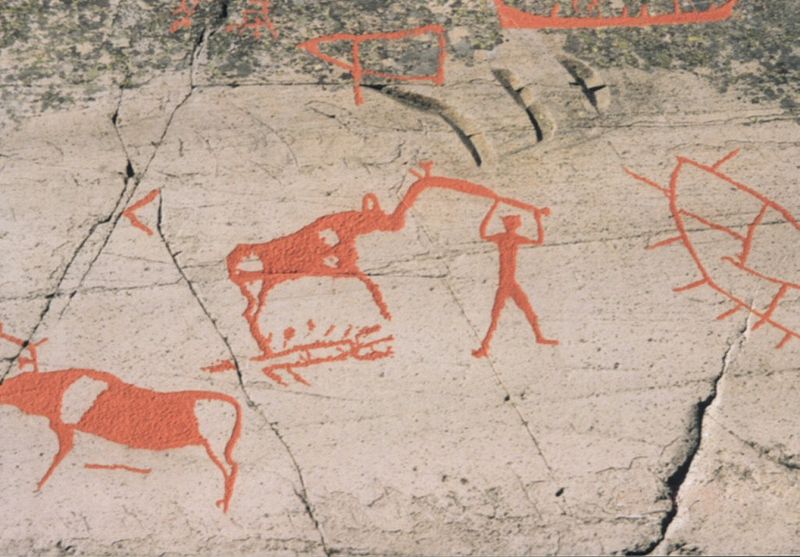 Stone Age Carving from Norway.
Stone Age Carving from Norway.
Complex Nordic Bronze age carving of obvious similar creation as the design above.
Rock carving form Norway (Over 6000 years old) Showing unique artistic elements.
Norway 1200BC
Many images on these stones dating from 6000 years ago tothe Iron age depict many traditions found in Germanic and later Viking age culture such as waging war on boats, farming/herding, fishing, ship design, beings in Germanic religion and symbols found throughout Nordic culture prehistoric to modern. When looking at these images one could understand how the Runes may have evolved out of it stylistically. The exact culture responsible is unknown in some cases but elements can be traced to later Nordic customs.
STONE CARVING PHOTO’S ARE FROM WIKIPEDIA. Copyright to respective owners.
A small gallery of images and symbols. Art of my own creation is marked.

Irminsul: Ancient German totem most likely of Yggdrasil (World tree) Symbol is associated with The Saxons and a Deity called Irmin who is most likely Odin under one of his alias/regional names. (Photo by Varus111) Reconstructed Irminsul in Hildesheim Germany.

Thor-Thunor: Nordic Thunder God. Viking age bronze statue.
Helmet replica from the Sutton-Hoo find. Adorned with glorious plates referencing Nordic customs, legendary figures and amazing detailed metal work. (Not my photo)
Stone carving designs from Gotland Sweden. Copyright Call Of Steel 2012.
Gotland Sweden Stone Carving: Pre Viking. Copyright COS 2012.
Viking age stone carving from Gotland Sweden:Viking age. Copyright COS 2012.
Anglo Saxon decoration. Copyright COS 2012.
…………………………………..
In summary I hope this post gave at least some idea of Norse culture. It is near and dear to my heart as I descend from these mighty folk and try as an artist to keep some element of the old ways alive and well into the future.
Thanks for reading and stay tuned for more Blacksmith and historical posts.
Hroðberht-
My Shop
http://www.etsy.com/shop/NorseWest
Check out my shop for some very unique Jewelry and wrought iron pieces.
H-




